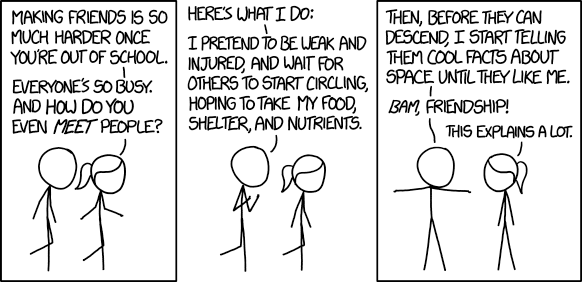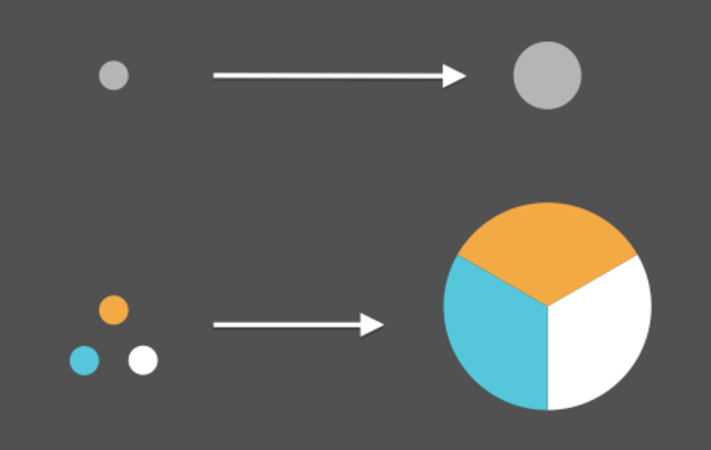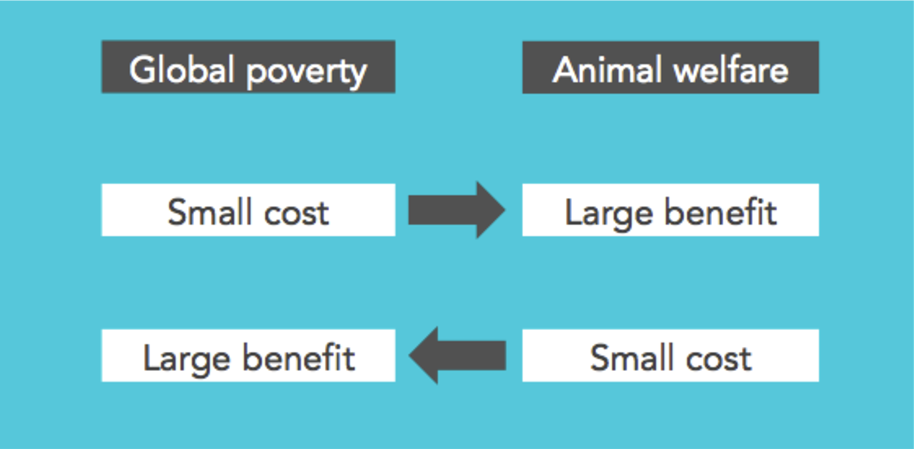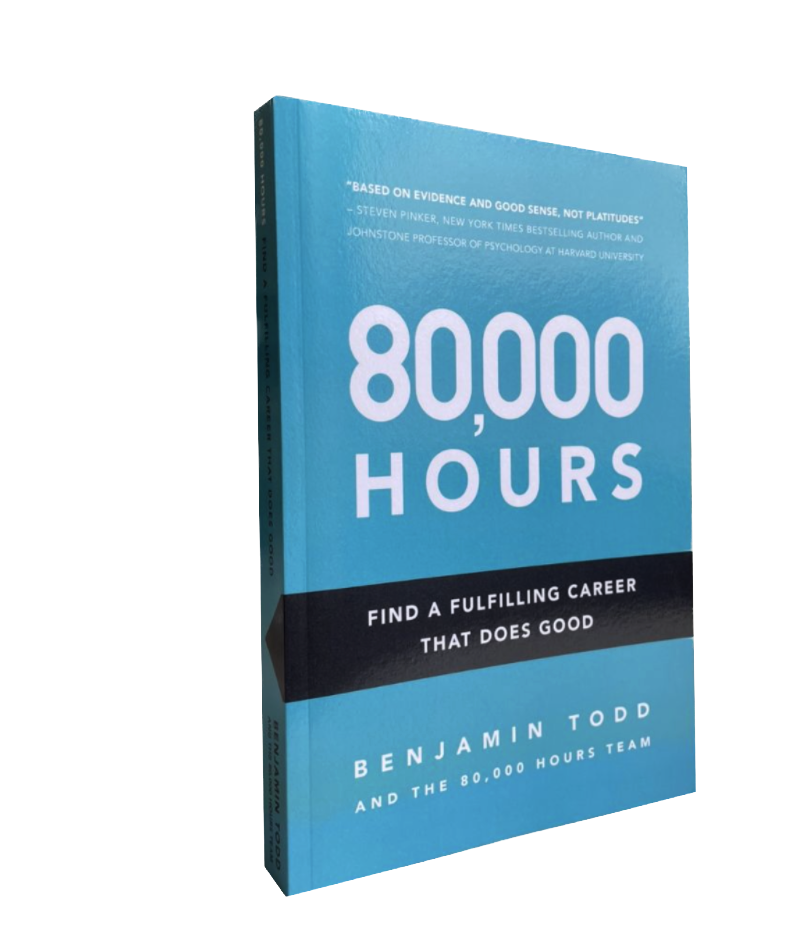Part 12: One of the most powerful ways to improve your career — join a community.

Not many students are in a position to start a successful, cost-effective charity straight out of a philosophy degree. But when Thomas attended an “effective altruism” conference in London in 2018, he discovered an opportunity to start a nonprofit that could have a major impact on factory farmed animals.
Through the community, he received advice and funding, and ended up in an incubation programme. Today, Thomas’s charity, the Fish Welfare Initiative, has reduced the suffering of around one million factory farmed fish, and has an annual budget of over half a million dollars.1
If Thomas had just added loads of people on LinkedIn, this would have probably never happened. And this illustrates what many people miss about networking: the value of joining a great community.
Finding the right community can help you gain hundreds of potential allies in one go.
In fact, getting involved in the right community can be one of the best ways to make friends, advance your career, and have a greater impact. Many people we advise say that “finding their people” was one of the most important steps in their career, and life in general.
What’s more, a group of people working together can have more impact than they could individually.
In this article, we’ll explain how joining a community can help, and how to get involved.
Reading time: 12 minutes
Table of Contents
Why joining a community is so helpful

There are lots of great communities out there. We’ve enjoyed being part of Y Combinator’s entrepreneur community — it made us more ambitious and more effective at running a startup… hopefully. We’ve also enjoyed participating in the Oxford philosophy ‘scene,’ the World Economic Forum’s Young Global Shapers, and many others.
Joining any good professional community can be a great boost to your career. In part, this is because you’ll get all the benefits of connections that we covered earlier: finding jobs, gaining up-to-date information, and becoming more motivated. But it goes beyond that.
Let’s suppose I want to build and sell a piece of software. One approach would be to learn all the skills needed myself — design, engineering, marketing, and so on.
A much better approach is to form a team of people who are skilled in each area, and then build it together. Although I’ll have to share the gains with the other people, the size of the gains will be much larger, so we’ll all win.

One thing that’s going on here is specialisation: each person can focus on a specific skill, and get really good at it, which lets them be more effective.
Another factor is that the team can also share fixed costs — they can share the same company registration, operational procedures, and so on. It’s also not three times harder to raise three times as much money from investors. This lets them achieve economies of scale.
In sum, we get what’s called the “gains from trade.” Three people working together can achieve more than three times as much as an individual working alone.
It’s the same when doing good. Rather than have everyone try to do everything, it’s more effective for people to specialise and work together.
An especially good thing about trade is that you can do it with people who don’t share your goals. Suppose you run an animal rights charity and meet someone who runs a global health charity. Now also suppose you don’t think global health is a pressing problem, and the other person doesn’t think animal rights is a pressing problem, so neither of you think the other’s charity has much impact. But maybe you know a donor who might give to their charity, and they know a donor who might give to your charity. You can trade: if you both make introductions, which is a small cost, you might both find a new donor, which is a big benefit.

This shows it can be valuable to join a community even if the people in it have different aims from your own.
That said, it’s far better again to join a community of people who do share your goals. Which brings us to…
Finding the right community for you
The people you spend the most time with have a big effect on what feels normal. If you spend time around generous people, you’ll see generosity as the norm. If you’re around people who regularly bend the truth, you’re likely to become less honest, because it’ll feel ubiquitous and acceptable.
So, choose your communities carefully.
Every community has a unique culture, so we recommend trying out several and seeing which are best for you.
And it’s healthy to spend time in several communities, so your sense of your identity and connections aren’t too dependent on one group or set of ideas, which can make the views of the group hard to question and have an ‘echo chamber’ effect.
As an exercise, make a list of several communities you might join, meet a variety of people and attend events within each one, and then get more involved in those (ideally more than one) that you think are most supportive for you at this time.
By “community,” we mean something very broad. It could be anything from a casual group of friends who are interested in the same thing, to larger movements, like animal welfare, with conferences and websites.
So when thinking about the communities you’d like to join, don’t only think about formal organisations. Rather, think about the types of people you’d most like to be around, and then think how you might achieve that. This could even involve setting up your own small “community,” by getting together a group of friends, starting a reading group or Slack, and so on.
Here are some categories to help you generate ideas:
- If you’re interested in working on a specific global problem, such as biosecurity or factory farming, there is probably at least one community (or several) in that field.
- If you’re focused on a particular way of doing good — such as research, writing, journalism, or entrepreneurship — there are probably communities around that.
- There are relevant political and ideological communities dedicated to broad ways of doing good, such as social entrepreneurship, progress studies, animal welfare, socialism, libertarianism, and social justice.
- Many of our readers also join communities that aren’t directly about doing good, but are supportive for personal development — e.g. nonviolent communication, rationality, and religious communities that promote important virtues.
Finally, there’s the effective altruism community, which we count ourselves as a part of.
How can the effective altruism community boost your career?
Effective altruism is the project of finding better ways to have a positive impact — for example, by looking for issues that are big in scale, highly neglected, and tractable.
It’s both a research field that aims to identify the world’s most pressing problems and the best solutions to them, and a practical community that aims to use those findings to do good. We helped to start the community back in 2011, along with several other groups.
Applying effective altruism means aspiring to apply four key values:
- Doing more to prioritise more effective ways of helping others.
- Striving to treat others more equally.
- Trying harder to question our beliefs.
- Working cooperatively with high integrity.
Anyone who shares these values and is trying to find better ways to help others is participating in the project of effective altruism, and has good reason to get involved in the community.
In fact, we know people who have been involved with Harvard Business School, the Fulbright Scholarship, the World Economic Forum, and other prestigious networks — but many of them say they find it more useful to meet people in the effective altruism community. Why?
One reason is that this community has a lot of amazing people, such as many of the people we interview on our podcast.
Another reason is that (as we’ve argued) you can increase your impact by working on issues and solutions that are more neglected — but if you’re working on something neglected, then (by definition) you won’t find many others who want to work on these issues in most conventional networks. Likewise, we’d argue it’s important to focus much more on comparing different options in terms of impact than is standard.
The effective altruism community is useful because you can find lots of people working on these neglected issues and applying these norms gathered in one place.
Behind this is an even more fundamental reason: the power of shared aims. You can work with people who don’t share your values because you can still trade with them — but if you share aims with someone else, then you don’t even need to trade.
In the effective altruism community, people share a common goal: to help others more effectively. So, if you help someone else to have a greater impact, then you increase your own impact too. You both succeed.
This means you don’t need to worry as much about getting favours back to break even. Just helping someone else is already impactful. This unleashes far more opportunities to work together than would be possible in a community where people don’t share one another’s aims as much. And because there are so many ways we can help each other, this makes it possible to achieve far more. (Read more in our article on coordinating with a community.)
Earning to give can actually be an example of that kind of collaboration. In the early days of 80,000 Hours, I (Benjamin) and my friend Matt had to choose between running the organisation and earning to give. We realised that Matt had higher earning potential, and I would be better at running the organisation. In part, this is why I became the CEO, and Matt became our first major donor, as well as a seed funder for several other organisations.
The alternative would have been for both of us to earn to give, in which case, 80,000 Hours wouldn’t have existed. Or, both of us could have worked at 80,000 Hours, in which case it would have taken much longer to fundraise (plus the other organisations Matt donated to wouldn’t have gotten those donations).
Within the community as a whole, some people are relatively better suited to earning money, and others to running nonprofits. We can achieve more if the people best suited to earning money earn to give and fund everyone else.
There are lots of other examples of how we can work together. For instance, some people can go and explore new areas and share the information with everyone else, allowing everyone to be more effective in the long term. Or people can specialise rather than needing to be generalists.
For instance, Dr Greg Lewis did the research into how many lives a doctor saves that we saw earlier. After realising it was fewer than he thought, he decided not to focus on clinical medicine. Instead, he’s studied public health with the aim of becoming an expert on the topic within the community, particularly on issues relevant to pandemics. He actually thinks risks from artificial intelligence might be more urgent overall, but as a doctor, he’s relatively best placed to work on health-related issues.
For all these reasons, if you share the aims of the effective altruism community, it can be a powerful community to join.
But we’d be remiss if we didn’t mention some of the downsides here too.
Effective altruism is still an unusual idea, and that means it attracts some unusual people. Even if you agree with its values, you might find you don’t gel with the people who have joined in practice.
Some find being part of the effective altruism community stressful — because of the focus on driving up positive impact, it can feel “totalising” to people. Others don’t like how tight-knit it is, or other aspects of the culture.
Try out getting involved (ideally with more than one group), and then reduce your involvement if it’s not supportive (while keeping a foot in some other communities to make this easier).
Effective altruism has also faced its fair share of controversy — especially since the collapse of FTX, which has many questioning the community’s organisations, culture, and even underlying ethos (for example, see this post by our founder).
You can see some of the most common critiques of effective altruism over its history on its Wikipedia page and on the FAQ at effectivealtruism.org.
All that said, if you liked this guide, then you’ll probably share aims with lots of people in the community, and get a lot out of it. We certainly have. So here’s what to do next, if you want to try getting involved.
How to get involved in effective altruism

The easiest thing to do right now is to join the Effective Altruism Newsletter. You’ll be sent a couple of emails that introduce the key ideas, a monthly update on new research, and be notified of the key conferences each year.
If you want to learn more about the ideas of the effective altruism community, you have a choice of introductions:
- Our podcast series: Effective Altruism: An Introduction.
- A short introduction by our president and cofounder Benjamin Todd.
- An academic article, Effective Altruism, by our other cofounder and Oxford philosopher Will MacAskill.
- A book: Doing Good Better, also by Will MacAskill.
Ways to meet people
Once you’re up to speed, try to meet people in person, since this is how to find connections that can really help your career. The best way to do this is to attend an EAGx conference. The EAGx series are locally organised conferences aimed at people new to the community. EAGx conferences have taken place in cities around the world — including Nairobi, Stockholm, Jaipur, Hong Kong, Sydney, and Boston — as well as virtually.
If you’ve already had some involvement in the community, you could attend an EA: Global event. They usually take place annually in London and San Francisco.
Alternatively, you can attend a local group event, or you can join the discussion online on the Effective Altruism Forum.
Once you’ve met a few people in the community, ask for more introductions.
Start by aiming to meet people in a similar situation to yourself, since there will often be opportunities to help each other. Then, try to speak to people who are one or two steps ahead of you in their career (e.g. if you want to start an organisation, meet people who started one last year).
When you’re getting involved, look for “five-minute favours” — quick ways you can help someone else in the community. There are probably some small things you can do that will be a great help to someone else in the community, such as making an introduction or telling them about a book. This will both have an impact and let you meet even more people.
Another way to get more involved is to visit one of the hubs of the community. These are, roughly in descending order of size:
- San Francisco
- London / Oxford / Cambridge (UK)
- Boston and Cambridge, Massachusetts (especially for biorisk)
- Washington, DC for US policy
- Plus New York, Sydney, Melbourne, Berlin, and many other major cities
Read more about why and how to visit.
See more tips on how to get involved and how to build connections.
Finally, here’s a list of other in-person and online events.
Other communities you may want to consider joining
There are many other great communities that can help you have more impact or be more successful. What matters is that you find people you can learn from and work with.
We know less about these communities, but we’ve got a few ideas about where to start.
First, we’d generally recommend getting involved in some communities especially focused on the global problems you’re most interested in.
For instance, if you want to work on reducing the existential risks posed by the development of AI, you could consider getting involved with the AI alignment community. You can learn a bit more about it here.
If you’re focused on factory farming, we’d recommend getting involved in the animal welfare community; if biorisk, the biosecurity community; if global health, the international development community (especially those focused on more evidence-based approaches like the ‘randomistas’); if nuclear war or great power conflict, then part of the international relations community.
Lots of academic fields have associated communities — if you’re starting out a career in academia, or are currently in college or grad school, talk to your professors to find out the best conferences to go to. These are usually worth getting involved in.
Finally, there’s been some overlap between effective altruism and the rationality community, and many of our readers have found benefits in both. The online hub of the rationality community is LessWrong.
How can communities work together more effectively?
If you’re already involved in a community, there’s a lot to say about how best to work together. We have a whole article about how to coordinate better in our advanced series.
Next up, let’s wrap up our entire career guide.
The end: A cheery final thought — imagining your deathbed
Or see an overview of the whole career guide.
Notes and references
- Fish Welfare Initiative’s donate page says that they managed to fully fund their 2023 budget, which they estimated at $662,385.
Its impact page estimates that it’s “potentially helped” approximately 1.13 million fish.
They say:
In “fish potentially helped,” we include all the fish living in a fish farm where 1) we have implemented a welfare improvement that we believe otherwise would not have been implemented, and 2) we feel ≥80% confident that the welfare improvement made a positive impact on the fish.
They also note the following limitations:
We don’t (currently) assess magnitude. The numbers of fish potentially helped do not consider the degree to which they were helped. While our welfare improvements theoretically should improve fish welfare, given the on-the-ground implementation difficulties and our current lack of a rigorous impact analysis, we are still significantly uncertain about the magnitude of our per-fish impact. Thus, it is unfortunately possible that our improvements are currently only having a trivial impact. To address this uncertainty, we plan to conduct an impact assessment in the coming year.
We generalize. It is possible that some fish counted may not have suffered in the absence of our intervention. For example, water quality is dynamic depending on where fish are in the pond. Thus, we do not know with certainty that all individuals would have suffered under water quality levels we deem inadequate.
We only count the fish we know of. It is common for there to be fish within a pond that have not been intentionally stocked by the farmer, such as invasive fish who enter the system through in-flow or fish that were not successfully removed in previous harvests. We expect that in almost all cases our improvements will also positively improve these fishes’ lives. However, we do not currently have a way to account for our impact on these individuals, so they are excluded.↩
